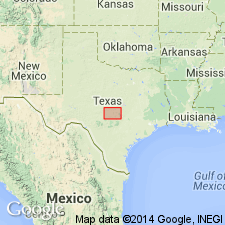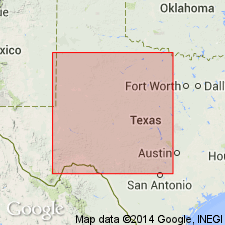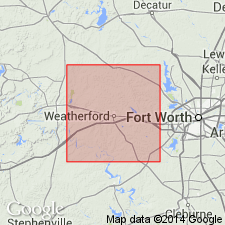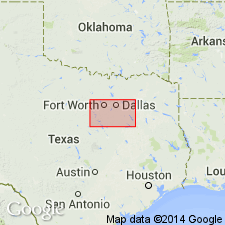
- Usage in publication:
-
- Turkey Creek sandstone member*
- Modifications:
-
- Original reference
- Dominant lithology:
-
- Sandstone
- Conglomerate
- AAPG geologic province:
-
- Bend arch
Summary:
Pg. 77-78 and many charts; Jour. Geol., v. p. 25, 31. Turkey Creek sandstone member of Mineral Wells formation. The thick, very massive sandstone which forms first prominent escarpment east of outcrop of Palo Pinto limestone has been named Turkey Creek sandstone, from creek of that name northwest of Mineral Wells (Palo Pinto County, central northern Texas). Thickness 10 to 15 feet. At type locality (on Turkey Creek Road 2.25 miles northwest of Mineral Wells) it consists of 10 feet of dark reddish-brown massive conglomerate of small angular pebbles of quartz and quartzite in a matrix of coarse sand, is overlain by Keechi Creek sandstone and shale and underlain by Salesville shale, all members of Mineral Wells formation.
[GNC remark (ca. 1936, US geologic names lexicon, USGS Bull. 896, p. 2198): Above is definition still in use. See F.B. Plummer and J. Hornberger, Jr., 1936, Univ. Texas Bull., no. 3534.]
Source: US geologic names lexicon, USGS Bull. 896, p. 2197-2198).

- Usage in publication:
-
- Turkey Creek sandstone member
- Modifications:
-
- Revised
- AAPG geologic province:
-
- Bend arch
Summary:
Pg. 66 (fig. 1), 87, 88. Turkey Creek sandstone member of Keechi Creek formation. Reallocated to member status in Keechi Creek formation. Basal member of formation; underlies unnamed limestones; overlies unnamed sandstones and limestone that overlie Dog Bend limestone member of Salesville formation. Name Mineral Wells dropped in this report. [Age is Middle Pennsylvanian.]
Source: US geologic names lexicon (USGS Bull. 1200, p. 3981).

- Usage in publication:
-
- Turkey Creek sandstone member
- Modifications:
-
- Areal extent
- AAPG geologic province:
-
- Fort Worth syncline
Summary:
Pg. 25, fig. 3, pl. 1. Turkey Creek sandstone member of Keechi Creek formation. Sandstone forms continuous trace from Parker County line, central northern Texas, to main east fork of Rock Creek and marks base of Keechi Creek formation. Thin to massive bedded, with faint evidences of cross-bedding; no conglomerate observed in Parker County. Thickness 10 to 12 feet. Underlies unnamed shale and sandstone member; overlies unnamed shale member of Salesville formation. [Age is Middle Pennsylvanian.]
Source: US geologic names lexicon (USGS Bull. 1200, p. 3981).

- Usage in publication:
-
- Turkey Creek Sandstone [unranked]
- Modifications:
-
- Mapped 1:250k
- Dominant lithology:
-
- Sandstone
- AAPG geologic province:
-
- Bend arch
Summary:
Turkey Creek Sandstone [unranked] in Mineral Wells Formation of Strawn Group. Coarse-grained, locally chert conglomerate, cross-bedded, massive, reddish brown. Thickness 10 to 50 feet, feathers out abruptly southwestward. Lies above Dog Bend Limestone [unranked] in Mineral Wells Formation. Age is Middle Pennsylvanian (Desmoinesian).
[Age is considered early Late Pennsylvanian (early Missourian). Early-Middle Pennsylvanian boundary tentatively placed between Village Bend and Lake Pinto (see Geol. Atlas Texas, Dallas sheet 1987 entry under Mineral Wells). Boardman and others, 1994, Kansas Geol. Survey Bull., no. 232, p. 8, 14 (fig. 8) state boundary is 15 to 25 feet above Village Bend, based on fusulinids, conodonts, and ammonoids.]
Mapped in Palo Pinto Co., central northern TX.
Source: Publication.
For more information, please contact Nancy Stamm, Geologic Names Committee Secretary.
Asterisk (*) indicates published by U.S. Geological Survey authors.
"No current usage" (†) implies that a name has been abandoned or has fallen into disuse. Former usage and, if known, replacement name given in parentheses ( ).
Slash (/) indicates name conflicts with nomenclatural guidelines (CSN, 1933; ACSN, 1961, 1970; NACSN, 1983, 2005, 2021). May be explained within brackets ([ ]).

